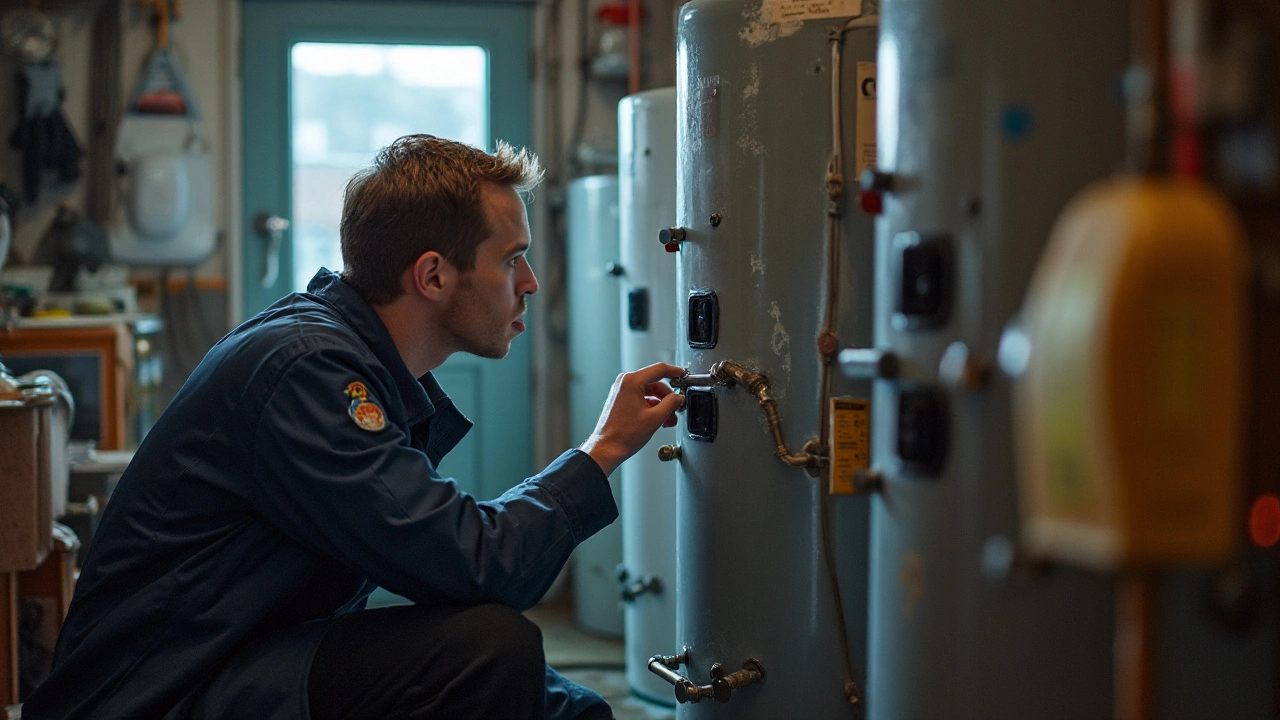Imagine starting your day with a cold shower because your hot water heater suddenly stopped working. Frustrating, right? One common issue with water heaters is the reset button tripping. This can leave you with icy water instead of the warm, comforting cascade you were expecting.
The reset button acts as a safety feature, preventing the water heater from overheating, which could cause damage or even pose a safety hazard. Understanding why it trips is essential for anyone wanting to maintain a functional, efficient water heating system.
Whether you're an experienced DIY enthusiast or a curious homeowner, this guide will shed light on the main culprits behind this issue, how you can evaluate the situation, and when it might be time to seek professional help. Equip yourself with the right knowledge to keep your water heater in top shape and enjoy hot showers without interruptions.
- The Role of the Reset Button
- Common Causes for Tripping
- Diagnosing the Problem
- Simple Solutions for Homeowners
- When to Call a Professional
- Preventive Measures for Longevity
The Role of the Reset Button
When it comes to managing your home's hot water, the reset button on your heater plays a pivotal part. This little component serves as both a sentinel and a lifesaver, ensuring your water heater doesn’t turn into a runaway steam engine. Essentially, it's a safety device dedicated to preventing overheating, which occurs when a malfunction causes the water temperature to rise dangerously. The reset button acts as a circuit breaker; when temperatures surpass safe limits, it steps in to cut off power to the water heater until things are back under control.
Now, you might wonder why such a mechanism is necessary. Consider this: water heaters operate within very specific temperature ranges—generally between 120 to 140 degrees Fahrenheit. This range isn't just about your comfort; it’s about ensuring safety. When water remains in the heater tank too long or is heated excessively, it could lead to pressure build-up. If unchecked, it might even result in explosions or severe leaks, leading to damage that could be both dangerous and expensive.
The advent of reset buttons has mitigated such risks significantly, as they provide a fail-safe. This is where the reset button’s role becomes crucial. It's a contributing factor to the longevity and safety of these indispensable home appliances. A reset button is typically linked to the thermostat inside the heater. If the thermostat fails and doesn't cease heating at the designated temperature, the reset button opens the circuit, preventing relentless heating. This isn't something you'd want to test, but it's comforting to know it’s there. A safety stopgap, as some experts say, is worth its weight in gold.
As you delve deeper into the functions of your water heater, it’s important to recognize the reset button's significance. If you ever find yourself repeatedly pressing this button, it's a sign that your system may be asking for help. Warranted attention at the right time can save you from larger troubles. As noted by an engineer in the field, “The reset button is designed to trip under specific circumstances. If it's doing so too often, there’s a root problem that requires a closer inspection.”
Understanding this component empowers homeowners to maintain not just the efficiency but also the safety of their water heating systems. Utilizing knowledge about the reset button, combined with timely checks and balances, ensures that the water heater operates smoothly and continues to serve its purpose effectively. This component, though small and seemingly insignificant, is central to the operation and safety of your home’s hot water supply. It’s an ally worth acquainting yourself with, especially if high water temperatures are a daily essential for your lifestyle.
Common Causes for Tripping
When it comes to your trusty water heater, the reset button tripping can turn a promising morning into a less-than-pleasant surprise. One of the most frequent culprits is a faulty thermostat. Thermostats are the brains behind the operation, regulating the temperature of the water. If either the upper or lower thermostat malfunctions, the heating element may get confused and not shut off as it should, causing the reset button to trip as a protective measure against overheating.
Another reason your reset button might be acting up is due to a short in the heating elements themselves. Water heaters typically have two heating elements, one at the top and one at the bottom. If these elements become damaged or simply wear out over time, they might short-circuit, causing an irregular flow of electricity. This not only compromises heating efficiency but can also trigger safety mechanisms like the reset button.
Internal Electrical Problems
Internal electrical issues, such as wiring that has been damaged or improperly installed, are also common offenders. When connections become loose or corroded, the electricity may not flow as intended, leading to overheating and tripping the reset. This scenario can be quite tricky, as the problem may not be immediately visible and often requires a thorough inspection to identify the source of the fault.
The importance of maintaining safety features in electrical appliances is summed up well by the experts at Energy Saver, who emphasize, "Regular maintenance and timely diagnostics can prevent most safety mechanism failures, enhancing both appliance lifespan and household safety."
It turns out that environmental factors can play a role too. Sediment build-up, usually from the minerals in hard water, can settle at the bottom of the tank. This build-up creates a barrier between the heating elements and the water, forcing the system to work overtime to heat the water to the desired temperature. The additional strain not only affects efficiency but also the longevity of your unit. Regularly draining your tank can help mitigate this issue, keeping both your energy bills and repair costs down.
High Thermostat Settings
Finally, setting the thermostat too high might lead the reset button to do its job more often than necessary. Many users unwittingly increase the water heater temperature thinking it will provide more hot water. In truth, it simply increases your risk for a scald hazard while making the unit more susceptible to overheating. Keeping your thermostat set at a moderate level, around 120 degrees Fahrenheit, can often prevent unnecessary resets and save energy.
In sum, understanding these hot water issues is vital for anyone interested in extending the life of their water heater and keeping their home running smoothly. With a bit of knowledge and attention, many of these common causes for tripping the reset button can be addressed before they become significant problems.

Diagnosing the Problem
Pinpointing the exact reason why the reset button on your water heater has tripped requires a bit of detective work. The first thing you should note is the age and model of your heater, as older models tend to have more frequent issues. Begin by checking the thermostat, which often plays the role of a puppet master in setting off the reset button. If it's set too high, the heater will overwork itself, tripping to prevent any potential calamity.
Inspect the heating elements, which are susceptible to failure over time. Minerals in the water can accumulate, causing sediment buildup, and leading to an impaired heating element. This results in less efficiency and forces the unit to overcompensate, triggering the reset mechanism. A simple multimeter test can reveal if the elements have gone bad or are nearing their expiration date.
It's also wise to be mindful of wiring issues that might plague the system. Loose or frayed wires can cause short circuits, additional stress, or even fire hazards – all situations where the reset button becomes a lifesaver. A close look at the wiring connections might sometimes reveal the tip of a larger iceberg.
According to the U.S. Department of Energy, water heating accounts for about 18% of home energy use, which highlights the importance of maintaining an efficient system.
Then there's the possibility of a faulty reset button itself. After all, malfunctions aren’t just confined to heating elements or wiring. If you suspect this, replacing the button might be a worthy investment, especially if it seems to trip inconsistently without clear cause. Lastly, examine the surrounding environment; if the location of your water heater doesn't allow good airflow, it might overheat more often, becoming a perfect candidate for resetting mishaps.
Signs of a Deeper Issue
Sometimes diagnosing a tripped reset button may reveal an underlying symptom of a deeper issue, like an overtaxed circuit breaker or a more intricate electrical problem. This could require checking other systems connected to the same circuit or even specific operational trials. Using caution, turn off the power supply and remove the heater’s access panel to get a better look at the internal components. Simple checks, like feeling for excessively hot wires or noticing burnt plastic smells, can offer clues. At times, these investigations show that what seemed like a tripping button was a mere surface symptom of a more profound electrical strain.
Hot water issues generally point towards operational inefficiencies that develop over time or manifest suddenly due to component failure. Using diagnostic approaches like these gives homeowners a fighting chance to address issues before they spiral into significant repairs or replacements. However, if DIY methods leave you scratching your head or require actions beyond your comfort zone, pushing the task to a licensed technician is the smartest move.
Simple Solutions for Homeowners
For most homeowners, a water heater's tantrums can feel intimidating. They're tucked away, usually out of sight, and often forgotten until something goes awry. But, when the reset button trips, don't let panic set in. There are a few straightforward methods you can employ before dialing a pro. Let's dive into some simple strategies that might get your hot water flowing again.
One of the first areas to check is the temperature setting on your water heater. A common reason for the reset button (or the "high-limit switch") tripping is an inappropriate temperature setting. Set too high, it can lead to overheating. Most experts recommend a setting between 120 to 140 degrees Fahrenheit for optimal performance and safety. To adjust it, locate the thermostat behind a panel on the water heater and use a flat-head screwdriver to turn the dial.
An often overlooked aspect of water heater maintenance is the accumulation of sediment at the bottom of the tank. Over time, minerals from hard water build up into sediment layers and can cause overheating, subsequently tripping the reset button. If it’s been a year since the last flush, or if you use well water, it might be time to drain your water heater. Start by turning off the power, attach a hose to the drain valve, and let the water run until the tank empties. This simple flush can help maintain your water heater's efficiency and prevent future reset button trips.
If the reset button persists in its rebellious behavior, check the unit's power supply next. Frequently, the issue may stem from a loose wire or a blown fuse. A circuit breaker might have tripped, particularly after a storm. Heading to your electrical panel and double-checking for any tripped breakers might save you both stress and frustration. Remember always to proceed with caution and turn off the electricity to your water heater before handling electrical components.
Another potential solution lies in examining the heating elements themselves. With time, these elements can wear out or develop faults, leading to uneven water heating and, consequently, the reset button drama. This requires a bit more DIY enthusiasm, complete with a multi-meter to run a continuity test. But if you're up for it, replacing a faulty element can be a cost-efficient way to resolve persistent issues.
"Safety should always be your primary concern when dealing with water heaters. If you’re not comfortable or unsure about the procedures, it might be best to consult a professional," advises Fred Johnson, a respected technician with decades of experience in home appliance repairs.
You might also consider investing in a water heater insulation jacket. This can reduce heating costs and pressure on the unit, offering a long-term preventive measure against reset button trips. Keeping the heat in means less wear and tear on both your heater and your pocket.
These simple steps can often uncover hidden issues and remedy the problem without a hefty repair bill. While advanced problems will require professional help, tackling the basics on your own can save money and also teach you a thing or two about that unsung hero in your home — your water heater.

When to Call a Professional
Certainly, some water heater issues might be tackled with a bit of DIY spirit, but there comes a point when it’s wise to bring in a pro. One of the first indicators that it’s time to reach out to a specialist is if you find the reset button persistently tripping without an obvious cause. This typically suggests a deeper, perhaps more complex problem that requires a trained eye and experienced hands to properly diagnose. Poor wiring, faulty thermostats, or a malfunctioning heating element might be the underlying culprits, none of which are recommended for the untrained to meddle with.
Another situation where contacting a professional should be considered is when there are visible signs of rust or corrosion around the water heater’s components. These are red flags not only for the device’s operation but also potentially indicate a deterioration that could lead to leaks if left unchecked. In such cases, professionals have the right tools and knowledge to conduct a safe inspection and repair or replace parts as needed.
Water heaters can also exhibit signs of significant wear through odd noises, such as pops or bangs, which are often caused by sediment build-up within the tank. While minor sediment can be flushed out with a bit of effort, severe residues might require expert handling and possibly an upgrade to a newer unit. On this note, it’s worth remembering that the average life expectancy for such appliances typically ranges from 8 to 12 years, depending on usage and maintenance, and continual popping sounds might be whispering it’s time for an upgrade.
Another sign pointing to the need for professional intervention is inconsistent water temperatures. If your water can’t seem to find that sweet spot between rolling boil and polar plunge, a professional might be needed to examine the thermostats or heating elements for any discrepancies. They can calibrate or replace the faulty components to restore your water heater to proper functioning, ensuring those morning showers remain comfortably warm.
Hot water issues aren’t just an inconvenience – leaks, temperature inconsistencies, and electrical problems can pose serious threats to safety and property. The complex wiring and plumbing involved in these units make them best suited for those who’ve been schooled in the art of repair and safety regulations. An interesting insight from the Australian Institute of Plumbing and Heating highlights that attempting to fix these intricate devices without correct expertise can lead to dangerous outcomes, violating local safety regulations.
"Professional assessments are crucial for maintaining safety standards and ensuring your water heating systems operate with maximum efficiency," notes Ben Riley, a seasoned home safety auditor from SafeHome Australia.
Always consider the age and model of your unit as well. Older models are often less efficient and might require more frequent inspections and occasional tune-ups. Newer models, while generally reliable, may come with complexities that are best navigated by those who install and repair them for a living. In any case, consistently encountering troubleshooting hurdles might just mean it’s time to call in the cavalry and let those experienced hands take over.
Preventive Measures for Longevity
To ensure your water heater performs optimally over the years, taking proactive steps is crucial. A water heater repair can sometimes hit your wallet hard, so preventing complications is key. One simple yet effective measure is regular maintenance. By scheduling an annual inspection with a certified technician, you can catch any potential problems before they spiral into costly repairs. During these check-ups, professionals can clean out sediment build-up, which often leads to inefficiency and premature wear.
Additionally, insulating your water heater can make a significant difference. A cover or jacket helps maintain the heat within the tank, reducing energy consumption. This not only prolongs the life of the appliance but also slashes your electricity bill. It's worth considering insulating the pipes as well, especially if they are exposed to cooler environments which can further sap energy. Hot water issues become less of a concern when your system is well-insulated.
Another vital aspect of maintenance involves pressure relief valves. These must be checked regularly to ensure they are functioning properly. A faulty valve can lead to over-pressurization, which poses safety risks and can cause significant damage. Simple tasks like checking and replacing a faulty valve could save you from a potential disaster.
"Maintaining a water heater is much like maintaining a car. Regular care prevents breakdowns and extends its life," says John Warner, an expert in home appliances.
Adjusting the thermostat on your water heater might seem trivial, yet it plays a pivotal role in durability. Setting the thermostat to around 120 degrees Fahrenheit can minimize the risk of scorching, which contributes to wear and tear. Moreover, by doing this, you avoid trips of the reset button due to overheating, a frequent problem seen when temperatures are set too high.
| Maintenance Task | Estimated Lifespan Extension |
|---|---|
| Annual Inspection & Cleaning | 5 years |
| Insulation | 3 years |
| Thermostat Adjustment | 2-3 years |
Establishing a habit of flushing your water heater is another practical tip. Sediments and minerals can accumulate at the bottom, affecting the heater's efficiency and lifespan. Flushing helps in eliminating these deposits and maintaining a steady flow of water. Doing this twice a year is advisable, and it also helps prevent troubleshooting issues related to uneven heating or blockages.
Being mindful of water quality can influence heater longevity as well. Installing a water softener might be beneficial in areas with hard water because it reduces mineral deposits within the tank. This relatively simple addition can dramatically improve performance while extending the life of the unit.







